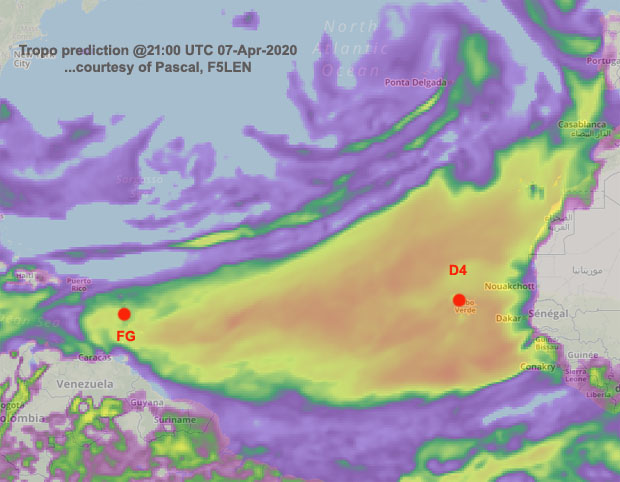On Tuesday the 7th of April 2020, a remarkable contact was made with the FT8 digital mode on 432 MHz between D4VHF on the Cape Verde Islands off the coast of Africa and FG8OJ in Guadeloupe in the Caribbean.
This was the first 70cms trans-Atlantic contact without using satellites or the moon. The most likely mode of propagation was marine ducting with the signal being trapped close to the ocean.
* * * * *
Update: Saturday 11th April 2020 - D4VHF in Cape Verde and WP3ND in Puerto Rico complete a contact with FT8 on 432 MHz. This extends the trans-Atlantic distance to approx 4,367 kms. Full info further down this post.
* * * * *
(Make sure to scroll down for updates)
This is a screen shot showing the FT8 contact between D4VHF and FG8OJ which was approximately 3,867 kms in length.
For the historic UHF contact, FG8OJ was using 100 watts from an ICOM IC-9700 into an 18-element Yagi antenna.
D4VHF in Cape Verde was using 100 watts into a 16-element Yagi as shown below...
According to the tropo forecast by Pascal, F5LEN, the conditions across the Atlantic were really good...
It's interesting to note that the 432 MHz signal from Cape Verde was first heard by 9Y4D in Trinidad on Monday the 6th of April 2020 at 18:48 UTC but no contact was made.
The distance from D4VHF to 9Y4D is even further at 4,006 kms.
* * * * *
Update - Friday 10th April 2020:
FG8OJ in Guadeloupe reports working D4VHF on SSB on 432 MHz at the end of Thursday the 9th of April after the FT8 signals had increased in strength.
FG4ST on Guadeloupe also works D4VHF with FT8 on 432 MHz, a distance of approximately 3,911 kms. Amazingly, FG4ST was just using a Diamond X-50 vertical and 50 watts for the contact.
This is the tropo prediction from F5LEN for the trans-Atlantic path on the 10th of April...
To put these remarkable contacts into some sort of perspective, remember that the distance from Newfoundland to Ireland across the North Atlantic is 3,000kms.
9Y4D in Trinidad finally works D4VHF via FT8 on 432 MHz. This now extends the trans-Atlantic distance on 70cms to 4,009 kms!
 |
| 432 MHz Crossed Yagi used by 9Y4D |
* * * * *
Update - Saturday 11th April 2020
Saturday 11th April 2020. Time 01:08 UTC. D4VHF in Cape Verde and WP3ND in Puerto Rico complete a contact with FT8 on 432 MHz.
WP3ND - D4VHF WWLOC: FK68vk- HK76MU79VB
The distance is approx 4,367 kms which is about 500 kms further than the contact that D4VHF had with FG8OJ and about 360 kms further than 9Y4D.
Rig and antenna for WP3DN...
* * * * *
432 MHz... Some of the reception reports of D4VHF on FT8 from the PSKReporter website...
12th Apr 2020 - (It looks as if this might be the last day of the opening)
9Y4D 70cm FT8 4006 km 01:12:14
11th Apr 2020
FG8OJ 70cm FT8 3867 km 17:27:44
WP3DN 70cm FT8 4363 km 05:24:44
WP4G 70cm FT8 4358 km 04:45:14
9Y4D 70cm FT8 4006 km 03:46:14
NP4BM 70cm FT8 4450 km 02:04:44
FG4ST 70cm FT8 3911 km 01:30:14
FG8OJ 70cm FT8 3867 km 01:29:44
10th Apr 2020
FG8OJ 70cm FT8 3867 km 19:27:14 (+4dB)
FG4NN 70cm FT8 3885 km 19:15:14
FG4SU 70cm FT8 3833 km 18:55:14
FG4ST 70cm FT8 3911 km 18:43:44
FG8OJ 70cm FT8 3867 km 12:20:14
9Y4D 70cm FT8 4006 km 11:12:14
FG8OJ 70cm FT8 3867 km 01:03:14
9th Apr 2020
J69DS 70cm FT8 3865 km 19:58:44
8th Apr 2020
Rcvr Band Mode Distance Time (UTC)
9Y4D 70cm FT8 4006 km 18:31:14
9Y4D 70cm FT8 4006 km 13:23:14
7th apr 2020
Rcvr Band Mode Distance Time (UTC)
FG8OJ 70cm FT8 3867 km 23:35:14
Ongoing...


















5 comments:
That's excellent! If it wasn't going to happen on that path, it wasn't going to happen at all. I'm still pointing my 8-ele (144MHz) at the US, ready to pounce. But that path is not often tropo-fied in the way more equatorial regions are.
Well done, boys!
Almost 20 years ago it was predicted that tropospheric ducting would be the most likely mechanism for spanning the Atlantic Ocean. See QST magazine: https://www.arrl.org/files/file/Technology/tis/info/pdf/0208036.pdf and it's concurrent publication in RadComm in Europe. Granted, the right conditions happen more often at low latitudes, however persistence is key to linking NA with EU. It is only a matter of time.
There is a whole truckload of Sahara dust getting across the Atlantic this week. I blame it for the modification of the normal atmosphere into a superrefractive one, supporting communications for the first time on this band. Sahara dust dryes the air around it by absorbing moisture and thus modifying the refraction index. Like a G-Line feeder or an optical fiber, the difference in refraction index between different layers allows the propagation path to curve down following the Earth curvature to allow these fantastic QSOs.
I read about this phenomenon many years ago in an old ITU Bulletin justifying the enhanced superrefraction conditions usual between Cape Verde and the Western African Coast.
Jose, CO2JA
That was a interesting read.
Thanks for this great reportó.
De CE6SAY
FF31qr
73
Post a Comment